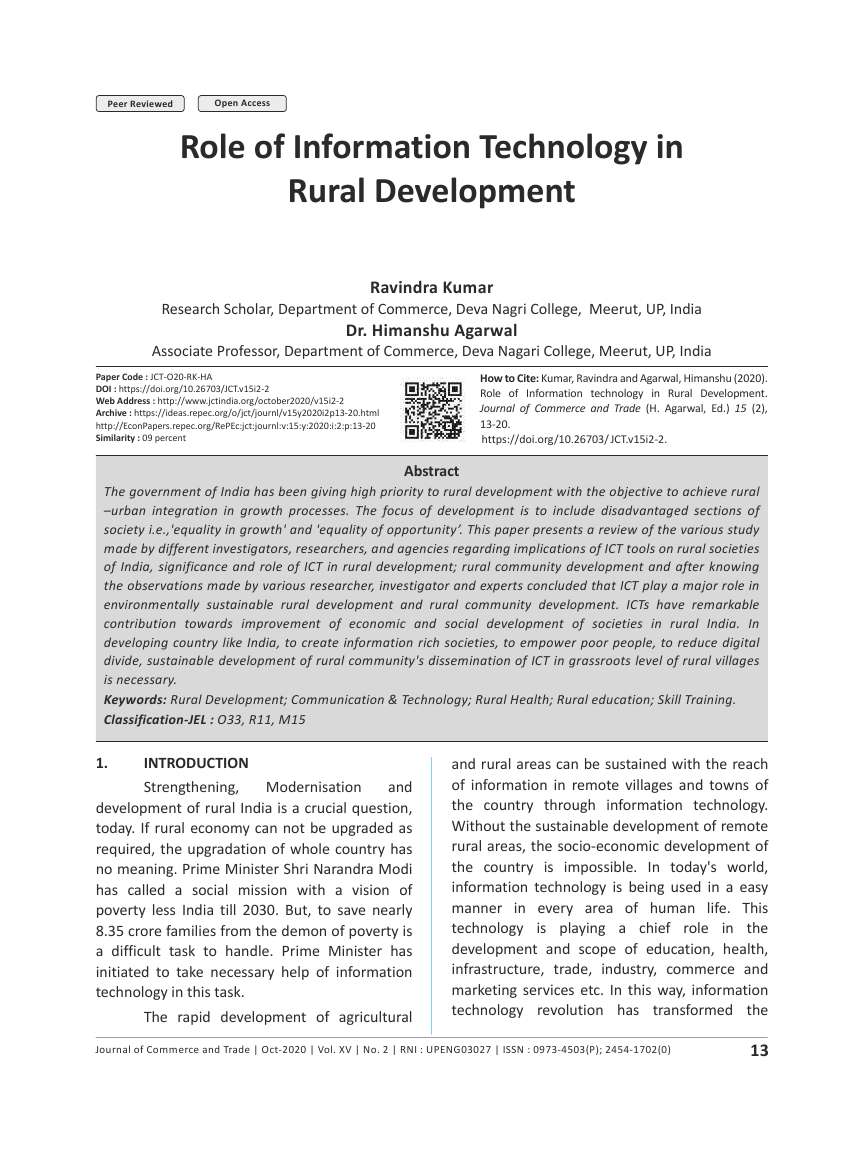Role of Information Technology in Rural Development
DOI:
https://doi.org/10.26703/jct.v15i2.3Keywords:
Rural Development, Communication, Technology, Rural Health, Rural Education, Skill TrainingAbstract
The government of India has been giving high priority to rural development with the objective to achieve rural –urban integration in growth processes. The focus of development is to include disadvantaged sections of society i.e.,'equality in growth' and 'equality of opportunity’. This paper presents a review of the various study made by different investigators, researchers, and agencies regarding implications of ICT tools on rural societies of India, significance and role of ICT in rural development; rural community development and after knowing the observations made by various researcher, investigator and experts concluded that ICT play a major role in environmentally sustainable rural development and rural community development. ICTs have remarkable contribution towards improvement of economic and social development of societies in rural India. In developing country like India, to create information rich societies, to empower poor people, to reduce digital divide, sustainable development of rural community's dissemination of ICT in grassroots level of rural villages is necessary.
Downloads
References
Balwant Singh Mehta, “Capabilities, costs, networks and innovations: impact of mobile phones in rural India” working Paper available at http://www.capturingthegains.org/pdf/ctgwp-2013-29.pdf accessed on 15 March 2017.
Cecchini Simone and Christopher Scott. (2003). Can information and communications technology applications contribute to poverty reduction? Lessons from rural India. , Information Technology for Development, Vol. 10, Issue 2 (2003): 73 – 84.
David J. Grimshaw and Shalini Kala (2011) – Strengthening Rural Livelihoods: The impact of information and communication technologies in Asia - Practical Action Publishing Ltd., UK and the International Development Research Centre, Canada.
Indiresan, P.V. (1989). Technology planning for rural development. IASSI quarterly, 8 (1), 52-63.
Jangid, Umesh Arya. (2004). Information technology: boon or bane. Ed by Kiran Prasad. Information and communication technologies; recasting development, New Delhi: BR, 67-80.
Jayade, K. G., Khot, P. G., Ambani, G. - Study of Information Communication Technology in Agriculture in Vidarbha Region of Maharashtra State of India. International Journal of Software and Web Sciences (IJSWS), 9(2), June-August, 2014, pp. 115-119. Available at www.iasir.net accessed on 15 March 2017.
Malik, Netrapal and Bharadwaj, Neelam. (2001). Village information centers: a strategy of using information technology for rural development”. IASSI quarterly, 19(3), 103-113.
Manish Kumar, Chitra Pathak and Singh, A.K. (2001). Information sources of rural poor: a study in US Nagar district of Uttaranchal. IASSI Quarterly, 19 (3), 123-133.
Mathur, Akshay and Ambani, Dhirubhai. (2005). ICT and rural societies: Opportunities for growth. The international information & library review, 37 (4), 345-351.
Mehtha, Sanjeev and Kalra, Manmeet (2006). Information and Communication Technologies: A bridge for social equity and sustainable development in India. The international information & library review, 38(3), 147-160. Available at http://www.sciencedirect.com/science?_ob=Article.
Midda, Abdul Momin. And Mukhopadhyay, Sripati. (2006). Information and communication technology in e-education. Journal of library and information technology, 2(1), 42-48.
Mr. Atul D. Newase; Dr. Jitendra Sheetlani; Dr. Ranjit D. Patil; ICT: A Super Highway to Reaching the Unreached Rural Communities of India, IOSR Journal of Computer Engineering (IOSR-JCE), Volume 18, Issue 6, Ver. VI (Nov.-Dec. 2016), PP 08-11. [17] Neelameghan, A. (1998). Information technology and rural development. Information studies, 4 (1), 55-61.
Nikhil Sabharwal, Gaganpreet K Sidhu, ICT IMPLEMENTATION IN RURAL INDIA available at http://citeseerx.ist.psu.edu/viewdoc/ download? doi= 10.1.1.613.5951 &rep=rep1&type=pdf accessed on 16 March 2017.
Ogunsola, L.A. (2007). Africa in the global village: the challenges of co-operation and linkages in the 21st century. Library progress (international), 27 (2), 165-179.
P. Syama Thrimurthy (2009) “Information communication technology for rural areas” – Edited by P Adinarayan Reddy – Science and Technology for Rural development – The Associated Publishers, New Delhi.
Reddy, Naresh. (2003). I T for governance: opportunities. Information technology for participatory development. New Delhi: Centre for information research and development, 135-142.
Sharma, Aravind Kumar, (2007) Information needs and sharing pattern among rural women; a study. IASLIC Bulletin, 52 (3), 159-167.
Surabhi Mittal, Sanjay Gandhi, Gaurav Tripathi, “Socio-Economic Impact of Mobile Phones on Indian Agriculture”, working paper no.246, Indian Council for Research on International Economics Relations, New Delhi. Available at http://www.icrier.org/pdf/WorkingPaper246.pdf accessed on 12 March 2017.
Upadhya, Padma V. (1996) Information Technology and Community Development. Role of libraries in national development. New Delhi: ILA, 323-328.
Warner M. F., Adoption of ICT in agricultural management in the United Kingdom: the intra rural digital divide. Agriculture Economics, 48(1), 2002, 1-http://www.agriculturejournals.cz/publicFiles/59184.pdf accessed on 03/12/2016.

Downloads
Published
Issue
Section
License
Copyright (c) 2020 Ravindra Kumar, Dr. Himanshu Agarwal

This work is licensed under a Creative Commons Attribution 4.0 International License.










